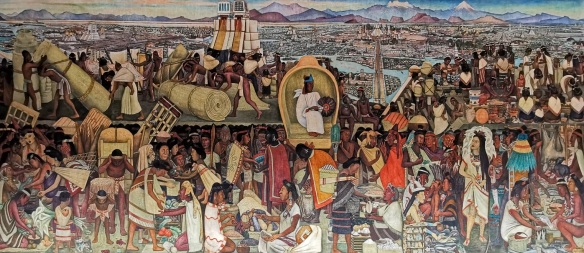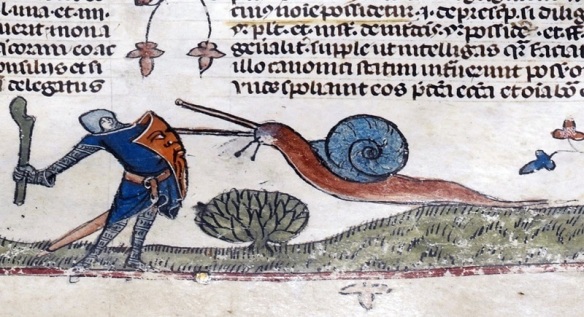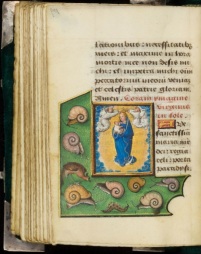Land snails have featured in the human culture from ancient times. From the earliest times, snails have been part of myths and legends, some even depicting the creation of the world. Snails are often symbolized by their spiral shape or their slowness linked to laziness.
From Nauru only 3500 km from eastern Australia, comes the creation myth that at the beginning, the only things in existence were Areop-Enap (a spider) and the sea. Areop-Enap searched for food in the darkness and found an enormous clam which swallowed him. He used two snails and a worm to find a way to open the clam. Areop-Enap made the lower clam shell into Earth and the upper shell into the sky and sent the smaller snail west of the sky-shell where it became the Moon. The second snail was sent to the east and became the Sun.
Another creation myth from the Yoruba people of Nigeria tells that in the beginning, the universe consisted only of the sky, the water, and the wild marshlands. The God Obatala believed that the world needed more so he went to Olorun, ruler of the sky and creator of the sun, asking for permission to create mountains, valleys, forests, and fields. Obatala descends onto Earth to a place called Ife, carrying a snail shell filled with sand, a white hen, a black cat, and a palm nut. When he reached the earth, Obatala spread the sand and planted the nut. After a while, he decided to fashion human beings to keep him company because his task was quite lonely. Humans created by Obatala come together to form the first Yoruba Village in Ife.
A Navajo Indian tale from northern America tells that long ago, there was a mighty flood, and the People left their world, the Fourth World, the Underworld, and came up into the Fifth World, the world lived in today. They found themselves on the shore of a great ocean. The People broke into groups by clan and went out to find new homes. But at the end of four days, they came back to the place by the ocean as there was no fresh water to drink. First Woman stood in front of the People and said that someone would have to go back down to the old world below to find some fresh water. She sent several strong animals to find it but all were unsuccessful. A thin little girl called ‘snail girl’ offered to search though most thought she could not do this. First woman tied a bottle to the girl’s back and she set off slowly. After a long time, she found her way to the underworld and there she found some pure water. She filled the bottle and carried it back but it opened and spilled leaving a silvery trail. This created a large river. Snail girl was thanked and honoured by the People. First Woman declared that from that day on, the snail will carry the water bottle on her back as a symbol of her great journey. Snails will leave a trail of moisture behind at every place travelled as a message to everyone that our pure water is precious and must be taken care of.
At present, the Giant African Snail (Achatina fulica) is part of traditional religious ceremonies of Candomblé in Brazil where it is used as an offering to the deity called Oxalá.
Snails in ancient cultures
The spiral to many ancient cultures not only represented the cycle of life, death, and rebirth but represented the rotation of the Earth around the Sun. The spiral was considered the essence of the Universe and of time itself. The Sumerians and Babylonians considered the snails immortal, making them a symbol of eternity.
Prehistoric shell heaps, or midens (e.g. sambaquis in Brazil from 6000BC or Køkkenmøddinger from Denmark from 5000BC), bear witness to the amounts of shells processed by tribes through time. In Australia, shell midens created by coastal Indigenous Australian tribes often feature in Dreamtime stories. The Burarra people of Arnhem Land, also referred to as the Gidjingali, regard their midens as sacred sites.
In ancient Japanese times, snails were considered the most fertile of all animals and gods of water. Snails symbolised tolerance and perseverance and being hermaphrodite, had a duality symbol as in the process of mating they use both, male and female characteristics of their body.
The snail was a symbol in ancient Mesoamerican cultures. The Maya are probably the best-known of the classical civilizations of Mesoamerica. Originating in the Yucatán around 2600 B.C., they rose to prominence around A.D. 250 in present-day southern Mexico, Guatemala, northern Belize and western Honduras. The Mayan earth God, Pauahtan, the patron of scribes and of group of 5 unlucky days known as the Uayeb, emerges from a spiral shell. The ancient cultural centre of Mayans has stone building in the form of cylinder, the observatory for looking at Venus. The observatory is titled El Caracol, meaning ‘snail’. In Mayan mythology, the snail was associated with sexual desire.
The Aztecs were a Mesoamerican culture that flourished in central Mexico in the post-classic period from 1300 to 1521. At its greatest extent, the Aztec empire covered most of northern Mesoamerica. The ancient Aztecs saw the snail as a sacred being because its shell represented the cycle of life. To the Aztecs, the snail was symbolic of time, transition, and even fertility. Their beliefs are seen in ancient paintings, drawings, and carvings of the spiral snail shell. Their mythological story tells that when creating the Sun and the Moon, the gods let two different powers Tēcciztēcatl who started off as a lowly God of Snails and Worms, and Nanahuatzin, compete against each other. Their task was sacrifice by fire and they were to leap into the flames of a burning pyre. After Tēcciztēcatl hesitated, Nanahuatzin was first to sacrifice himself in the fire. Two suns then appeared in the sky but the gods who were angry with Tēcciztēcatl’s hesitation, threw a rabbit into Tēcciztēcatl’s face to reduce his luminosity. Subsequently, Nanahuatzin became the sun god Tonatiuh and Tēcciztēcatl was only awarded the status of moon god. Tēcciztēcatl carried a snail shell on his back. Just as the snail retreats into its shell, the moon retreats into the depths of the ocean. In this culture, the spiral snail shell is also symbolic of the moon, and its phases.
Quetzalcoatl is another Aztec god associated with the snail. He wore the spiral shell as a symbol on his chest. Therefore, he it was believed that he knew the secrets of reincarnation and the cycles of the Universe and of the gods. The Temple of Quetzalcoatl is decorated with snails and shells which are considered symbols of water.
In ancient Peru around 100 to 700 AD, the Mocha, an agriculturally based society, celebrated mountain sacrifices at the beginning of the rainy season which was marked by the appearance of snails in large numbers.
To the ancient Greeks, snails represented fertility and fruition of hard work. The presence of snails indicated when crops were ready to harvest. Hesiod, a poet who lived around the time of Homer, documented this noting that it was harvest time when snails climbed the stems of plants. Aristotle described the snail in detail and invented a spoon that allowed the snail’s body to be removed intact from the shell. Hippocrates studied the properties of slime mucus and praised its effectiveness in hydrating the skin, relieving skin irritations and redness, wound healing, and treating skin disorders. He also considered their consumption beneficial for various stomach disorders. Hippocrates and Galen considered snails to be beneficial for the treatment of herniation and hypersensitivity.
In early Christianity, the snail was a symbol of sloth and those who were content only with the material world. However, the snail also was said to symbolise Christ, a tradition that can be attributed to Tertullian, an early Christian author from Carthage, in his text Apologeticus. However, much controversy reigns on the symbolism particularly in early Christian art. Psalms 58:8 uses snail slime as a metaphorical punishment.
During Medieval times in Europe, before the Enlightenment, snail was also associated with laziness and it was considered an offense to call the person a snail, since it was the symbol of laziness, which was considered the strongest sin. The snail featured strongly in Gothic marginal warfare. Illuminated manuscripts of the 13th and 14th century depict motifs of man battling a snail. At times, the snail is huge, sometimes small. The snail may be across the whole page. sometimes it might be right under the knight’s foot. Usually, the knight is drawn so that he looks worried, astonished, or surprised by his tiny enemy. According to scholar Lilian Randall, the theory that best explains the unusual motifs is that snails represent Lombards, despised leaders who were vilified for treasonous and non-chivalrous behaviour in Europe at the time. So the snail actually represented the insult of insults during medieval times. The British Library agrees with this premise but says that the scene could also represent the Resurrection, a commentary on social oppression, or it could just be medieval humour. The remains an unsolved mystery.
Snails in art
The nature of art is taking totally different media, totally different ideas, and bringing them into a harmonious whole (Jones 2014). From still life paintings to works of contemporary art, land snails have been present in various artistic disciplines. They are often the subject of cartoons, poems and animated movies such as Turbo (2013) about a speed-obsessed snail with an unusual dream to become the world’s greatest racer. In The Secret Kingdom (Epic, 2013), another animated film, a snail called Grub appears to serve as the caretaker of Queen Tara.
Snails had a prominent role in many works of Christian art, where they were considered a symbol of sin, in addition to laziness. There was the belief also that they had been born from clay. Snail shells are used as decorative objects and are often incorporated into jewellery.
The Books of Hours were devotional books, each unique, that were widely popular in the later Middle Ages. The core text of any Book of Hours is a series of prayers, readings and psalms. Each one was made for a specific purpose and those for wealthy persons lavishly decorated. Snails featured in many of these folios e.g. Albrecht Durer, a German renaissance painter included a land snail in the margin of Emperor Maximillian the First’s Book of Hours on the page of Psalm 24: 1-3.
Species of land snails and slugs may be found on paintings and other works of visual arts from the late 15th century onwards. Initially, the illustrations were often imprecise but this changed in the late 16th century where most species were realistically illustrated. This was especially so during the 17th century, when still-life painting including one or more snails became well developed in Flanders and the Netherlands. Considered one of the great painters of the Netherlands, Jan Davidsz de Heem (Flowers in a Glass Vase with Fruit c. 1665) often included snails in his still lifes. Abraham Mignon (1640 – 1679) who studied under de Heem depicted snails in more than half of his still life paintings.
When Henri Matisse was prevented from painting by ill health and confined to bed, he produced a number of works known as gouaches découpées. These were made by cutting or tearing shapes from paper which had been painted with gouache. The shapes were placed and pasted down by an assistant working under Matisse’s instruction.
Famous Spanish surreal artist, Salvadore Dali, had an artistic repertoire that included sculpture, painting, photography, multimedia work. One of his more obsessive fetishes was the snail, because it incorporated the paradox of softness (the animal) with hardness (the shell). Well known works include the bronze, Snail and the Angel (conceived in 1977 and first cast in 1984) and his etching Apollinaire Secret Poems: Woman with Snail (1967) which symbolises impotence.
Gravestones are sometimes etched with snail images for they are seen as creatures that undergo resurrection when, after a long period of drought.
Snails have been used since prehistoric times to craft jewellery. Shell ornaments were very common from 50–40,000 years ago onwards. The first known examples of shell jewellery originated in Africa.




